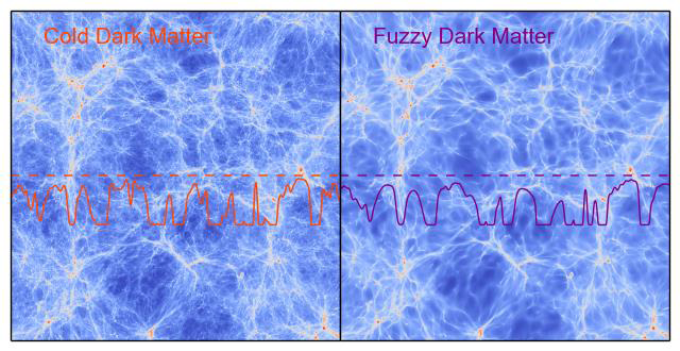Jul 24 2017
A web that passes through endless intergalactic spaces, a thick cosmic forest well-lit by very distant lights and an enormous enigma to solve are three picturesque concepts found in recent scientific research.
The research conducted by an international team comprising of Researchers from the International School for Advanced Studies (SISSA) and the Abdus Salam International Center for Theoretical Physics (ICTP) in Trieste, the Institute of Astronomy of Cambridge and the University of Washington adds a vital element for understanding one of the core components of the Universe: dark matter. To explore its properties, Researchers examined the interaction of the “cosmic web” – a network of filaments composed of gas and dark matter present in the entire Universe – with the light coming from extremely faraway quasars and galaxies.
Photons interacting with the hydrogen of the cosmic filaments produce numerous absorption lines defined “Lyman-alpha forest”. This microscopic interaction is effective in exposing several crucial properties of the dark matter at cosmological distances. The results additionally support the theory of Cold Dark Matter, which is made up of particles that move very gradually. Furthermore, for the first time, they focus the mismatch with another model, i.e. the Fuzzy Dark Matter, for which dark matter particles have greater velocities. The research was done through simulations on intercontinental parallel supercomputers and has lately been published in Physical Review Letters.
 On the left side the cosmic web in the standard cold scenario, on the right side how it would look like in the Fuzzy Dark Matter model. The curved lines in both panels show how the absorption by the neutral hydrogen in the cosmic web behaves in the two models. The right curve does not agree with the data, while the left one does. Credits: Matteo Viel
On the left side the cosmic web in the standard cold scenario, on the right side how it would look like in the Fuzzy Dark Matter model. The curved lines in both panels show how the absorption by the neutral hydrogen in the cosmic web behaves in the two models. The right curve does not agree with the data, while the left one does. Credits: Matteo Viel
Although constituting a vital part of the cosmos, the dark matter is not openly observable. It does not discharge electromagnetic radiation and it is visible only through gravitational effects. Besides, its nature is still a deep mystery. The theories that try to investigate this aspect are many. In this research, Researchers explored two of them: the so-called Cold Dark Matter, considered a paradigm of present cosmology and an alternative model called Fuzzy Dark Matter (FDM), in which the dark matter is believed to be made up of ultralight bosons provided with a non-negligible pressure at small scales.
To conduct their investigations, Researchers analyzed the cosmic web by examining the so-called Lyman-alpha forest. The Lyman-alpha forest comprises of a series of absorption lines created by the light coming from very faraway and very luminous sources, which travel through the intergalactic space along its way toward the earth’s telescopes. The atomic interaction of photons with the hydrogen existing in the cosmic filaments is used to examine the properties of the cosmos and of the dark matter at great distances.
Through simulations performed with supercomputers, Researchers replicated the interaction of the light with the cosmic web. Thus they were able to deduce some of the features of the particles that make up the dark matter. Specifically, evidence revealed for the first time that the mass of the particles, which supposedly make up the dark matter according to the FDM model, is not in keeping with the Lyman-alpha Forest observed by the Keck telescope (Hawaii, US) and the Very Large Telescope (European Southern Observatory, Chile). Essentially, the research seems not to verify the theory of the Fuzzy Dark Matter. The data, instead, confirms the scenario predicted by the model of the Cold Dark Matter.
The results acquired - Researchers say - are crucial as they allow construction of new theoretical models for explaining the dark matter and new hypotheses on the features of the cosmos. Furthermore, these results can offer advantageous indications for the realization of experiments in laboratories and can monitor observational efforts intended at making progress on this intriguing scientific theme.